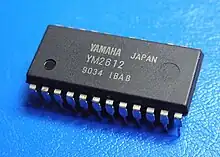
The YM2612, a.k.a. OPN2, is a sound chip developed by Yamaha. It is a member of Yamaha's OPN family of FM synthesis chips, and is derived from the YM2203.[1]
The YM2612 is a six-channel FM synthesizer. It was used in several game and computer systems, most notably in Sega's Mega Drive/Genesis video game console[2] as well as Fujitsu's FM Towns computer series.[3]
As with the YM3438, it was used by Sega in later models of the Mega Drive/Genesis (integrated into an ASIC) as well as in various arcade game systems, including the Mega-Play and Sega System 32.
Features
The YM2612 has the following features:[1]
- Six concurrent FM synthesis channels (voices)
- Four operators per channel[4]
- Two interval timers
- A sine-wave low frequency oscillator
- Integrated stereo output digital-to-analog converter (most other contemporary Yamaha FM chips require a separate external D/A converter chip)
- Per-channel programmable stereo sound (left, right, or both left and right resulting in centre)
- For channel three, operator frequencies can be set independently, making dissonant harmonics possible. (Normally, they would have a simple relation like e.g. 2× or 3× relative to a common base frequency)
Technical details
The YM2612's FM synthesis block is an extended version of the FM block featured in the YM2203, adding three FM channels and integrating a stereo output DAC.[1] The YM2612 removes the SSG component (although retaining its envelope generators) and I/O ports found in the YM2203, YM2608 and YM2610.[1] It was also available in CMOS form as the YM3438, a.k.a. OPN2C.[1]
Whereas the high-end OPN chips such as the YM2608 have dedicated ADPCM channels for playing sampled audio, the YM2612 does not. However, its sixth channel can act as a basic PCM channel by means of the 'DAC Enable' register, disabling FM output for that channel but allowing it to play 8-bit pulse-code modulation sound samples.[1] Unlike the other OPNs with ADPCM, the YM2612 does not provide any timing or buffering of samples, so all frequency control and buffering must be done in software by the host processor.[2]
Low volume distortion of the built-in DAC
Unlike most Yamaha FM chips which require an external floating-point DAC, the YM2612 features a built-in 9-bit DAC, which uses time-division multiplexing to play one sample of each channel in sequence, similar to the YM2413. Due to an error with the amplitude voltage in the original chip design, a peculiar form of crossover distortion known as low volume distortion is introduced in the output. Any output that is sufficiently low in volume undergoes an exaggerated quantization, including any usage of fades in video game music. Some early Sega Mega Drive/Genesis games such as After Burner II had their music written around this distortion, and as a consequence, the music sounds too quiet on later Sega Mega Drive/Genesis consoles that uses the integrated YM3438 chip on the ASIC. Also, because of the reduced dynamic range of the built-in DAC, additional distortion may be generated when playing sounds with a very high volume.[1]
Software implementation of the low volume distortion bug in the YM2612 has been implemented as a feature in many Sega Mega Drive/Genesis emulators since, where it was historically coined as the "ladder effect", or "TDM distortion".
Variants
Yamaha YM3438
The YM3438,[1] a.k.a. OPN2C, is a modified CMOS version of the YM2612, commonly used in Sega's arcade system boards. This version has an improved built-in DAC that fixed the low volume distortion bug that was present in the YM2612. It is not a direct, drop-in replacement for the YM2612 however, as the sound outputs have higher impedance.
Yamaha YMF276
The YMF276,[5] a.k.a. OPN2L, is a low-power version of the YM3438, used in the Fujitsu FM Towns II. It came in a smaller 24-pin SOP package. Unlike the YM2612 and YM3438, the YMF276 requires an external DAC chip. For this reason, a separate DAC chip known as the YM3433 was used here.
Sega Mega Drive/Genesis ASICs made by Yamaha (FC1004, FF1004, FJ3002 and FQ8007)
The YM3438 core was integrated in custom ASICs[6] used in the final revision of the Model 1 version and most revisions of the Model 2 version of the Sega Mega Drive/Genesis.
Game audio
Used in conjunction with the Texas Instruments SN76489 PSG as the main sound generators of the Sega Mega Drive/Genesis console, the YM2612 was prominently utilized by numerous prolific video game music composers, such as Yuzo Koshiro.[4][7]
See also
- VGM – an audio file format for multiple video game platforms, including the Sega Mega Drive/Genesis
- Yamaha YM2203
- Yamaha YM2608
References
- 1 2 3 4 5 6 7 8 YM3438 Application Manual (Japanese)
- 1 2 Sega Genesis Technical Manual - YM2612 section (updated with errors corrected)
- ↑ Purcaru, Bogdan Ion (13 March 2014). Games vs. Hardware. The History of PC video games: The 80's. p. 527. Retrieved 14 December 2017.
- 1 2 "Super Sonic: Creating the new sound of Sega's hedgehog hit". TheGuardian.com. 13 February 2020.
- ↑ Undocumented Sound Chips - Yamaha YMF276
- ↑ Sega Genesis 2 / Sega Mega Drive II Service Manual
- ↑ "Sega Mega Drive Mini review – a legacy truly honoured". TheGuardian.com. 19 September 2019.